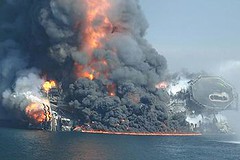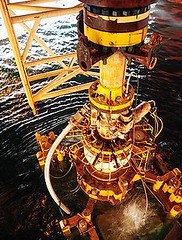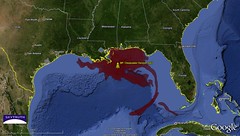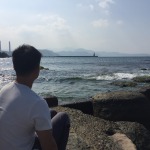 美國國家工程院(National Academy of Engineering)和美國國家科學研究委員會(National Research Council)日前針對海上鑽油平台災害發表檢討報告,指出鑽油公司應用「系統安全」的角度來預先評估、管理鑽油作業的每一個層面,以減低像是2010年墨西哥灣深水地平線油井爆炸及漏油災害的發生風險。
美國國家工程院(National Academy of Engineering)和美國國家科學研究委員會(National Research Council)日前針對海上鑽油平台災害發表檢討報告,指出鑽油公司應用「系統安全」的角度來預先評估、管理鑽油作業的每一個層面,以減低像是2010年墨西哥灣深水地平線油井爆炸及漏油災害的發生風險。
 這份因應美國內政部要求的報告強調,「系統安全」涉及每一個層面,包括確保維持油井的完善度、以及設計「能應對所有可預測狀況」的防噴器(編按:blowout preventer,又稱防噴閥,是油井作業過程中關閉井口,以防止井噴事故發生。先前有調查報告指出,BP公司深水地平線油井事故導因於防噴器失靈。)
這份因應美國內政部要求的報告強調,「系統安全」涉及每一個層面,包括確保維持油井的完善度、以及設計「能應對所有可預測狀況」的防噴器(編按:blowout preventer,又稱防噴閥,是油井作業過程中關閉井口,以防止井噴事故發生。先前有調查報告指出,BP公司深水地平線油井事故導因於防噴器失靈。)
2010年4月20日,距離路易斯安納州海岸50英里遠的BP公司深水地平線鑽油井爆炸,造成11名工作人員死亡及漏油近5百萬桶,是美國史上最大漏油事件。上述報告指出,這是一起連串判斷失誤的重大事故,而原因則在於,涉入營運的公司明顯欠缺有效的安全管理機制。
撰寫該報告的委員會主席、前美國海軍部長溫特(Donald Winter)談到,「維持國內油源穩定是重要的,所以也必須保護那些從事近海鑽孔作業人員、和仰賴墨西哥灣的生計。」他表示,「企業主和管理者必須根據鑽油作業會遇到的所有危機,做出切於事實本質的評估,並對許多複雜系統的全面安全性等級排出優先次序。」
 報告中提到,儘管油井的地理位置本身就較為險峻(在距離墨西哥灣海平面下一英里的深海,再往下鑽18,360英尺深度),但目前已經有可行技術可與作業程序,可以讓油井安全地「暫時關閉」(temporary abandonment)。所謂「暫時關閉」的狀態,是指先將油井封存(seal),等待其他設備安裝到位以進行後續原油提煉程序。
報告中提到,儘管油井的地理位置本身就較為險峻(在距離墨西哥灣海平面下一英里的深海,再往下鑽18,360英尺深度),但目前已經有可行技術可與作業程序,可以讓油井安全地「暫時關閉」(temporary abandonment)。所謂「暫時關閉」的狀態,是指先將油井封存(seal),等待其他設備安裝到位以進行後續原油提煉程序。
報告中觀察到,管理部門和工作人員忽視數個即將發生的警訊,導致無法立即做出回應。而儘管過去有許多潛在防噴器失靈訊號發生,報告中發現企業主和管理者對油井噴漏安全失靈機制能力上產生「認知上的錯誤判斷」。
而普遍使用的防噴器系統,包括深水地平線所使用的,在設計及測試上都無法對災害狀況做出動態回應。
報告也指出,管理者未履行有效監督之責,建議強化作業規範,制定鑽油作業的最高安全標準,並在幾個關鍵程序接受強制性監督。
報告中說,防噴器系統應該重新設計、嚴格測試和維持操作的可靠性。在緊急狀態下使用系統的適當訓練也是重點。
報告中建議企業主和管理者,應積極推廣正規教育和海上鑽油作業員的教育訓練,來確保他們能適當地執行系統。並建議設立指導方針,讓油井設計上結合保護措施。來避免許多在鑽孔作業上和「暫時關閉」過程中潛在危機的發生。
除此之外,用來阻擋原油溢出的水泥及機械裝置,應加以測試來確保有效與否,而且測試程序應由獨立專家,透過「即時觀察」來評估。
報告也建議改進安全事故的通報程序,開放匿名通報;公司也應該針對所有通報內容作調查,並將檢討結果告知全體員工。最後,現行海上鑽油作業的管理單位眾多,有疊床架屋之弊,美國應設置單一獨全權負責完善所有海上鑽油活動的系統安全。
Companies involved in offshore drilling for oil should take a "system safety" approach to anticipating and managing potential dangers at every level of operation to reduce the risk of another catastrophic accident such as the Deepwater Horizon explosion and oil spill, finds a new report on the disaster from the National Academy of Engineering and National Research Council.
The system safety approach should extend from ensuring the integrity of wells to designing blowout preventers that function "under all foreseeable conditions," emphasizes the scientific and engineering report, which was requested by the U.S. Department of the Interior.
The report says the lack of effective safety management among the companies involved in BP's Macondo Well-Deepwater Horizon disaster is evident in the multiple flawed decisions that led to the April 20, 2010 blowout and explosion of the rig 50 miles off the coast of Louisiana. Eleven workers were killed and the nearly five million barrels of oil were spilled, the largest accidental oil spill in U.S. history.
"The need to maintain domestic sources of oil is great, but so is the need to protect the lives of those who work in the offshore drilling industry as well as protect the viability of the Gulf of Mexico region," said Donald Winter, former secretary of the Navy, and chair of the committee that wrote the report.
"Industry and regulators need to include a factual assessment of all the risks in deepwater drilling operations in their decisions and make the overall safety of the many complex systems involved a top priority," said Winter.
Despite challenging geological conditions for the well - situated in deep waters more than a mile below the surface of the Gulf of Mexico and drilled 18,360 feet beneath the sea floor - the report says alternative techniques and processes were available that could have been used to prepare the well safely for "temporary abandonment."
In that state, the well would have been sealed until the necessary infrastructure could be installed to support hydrocarbon production.
This report observes that several signs of an impending blowout were missed by management and crew, resulting in a failure to take action in a timely manner.
And despite numerous past warnings of potential failures of blowout preventer systems, the report finds that both industry and regulators had a "misplaced trust" in the ability of these systems to act as fail-safe mechanisms in the event of a well blowout.
Blowout preventer systems commonly in use, including the system used by the Deepwater Horizon, are neither designed nor tested to operate in the dynamic conditions that occurred during the accident, the report states.
Regulators also failed to exercise effective oversight, the report finds. It recommends an enhanced regulatory approach that combines strong industry safety goals with mandatory oversight at critical points during drilling operations.
Blowout preventer systems should be "redesigned, rigorously tested, and maintained to operate reliably," the report says. Proper training in the use of these systems in the event of an emergency is also essential.
The report recommends that both industry and regulators should "significantly expand" the formal education and training of personnel engaged in offshore drilling to ensure that they can properly implement system safety.
It recommends that guidelines be established so that well designs incorporate protection against the various credible risks associated with the drilling and abandonment process.
In addition, finds the report, cemented and mechanical barriers designed to contain the flow of hydrocarbons in wells should be tested to make sure they are effective, and those tests should be subject to independent, near real-time review by a competent authority.
Reorting of safety-related incidents should be improved to enable anonymous input, and corporations should investigate all such reports and disseminate lessons learned to personnel and the industry as a whole. Finally, because offshore drilling operations are currently governed by a number of agencies, sometimes with overlapping authorities, the U.S. should make a single government agency responsible for integrating system safety for all offshore drilling activities.







